Summary
Historically, many senior radio managers have feigned ignorance of, and abdicated responsibility for, the technical aspects of getting programmes to listeners. Although it is not necessary for the manager to have a component-level knowledge of the technology behind today's digital media, a basic understanding of the capabilities and potential of the new technologies provides a real advantage for maximising the performance of any mass medium. Here we will cover the broad issues that most often cause concern or confusion for the non-technical manager.The Programme Chain
The path that programme material takes through the broadcasting system is often referred to as the programme chain since it is only as good as its weakest link. Any distortion or noise added at any point cannot be removed later except with difficulty. The simplest chain, for example, in a Restricted Service Licence station, might look like this: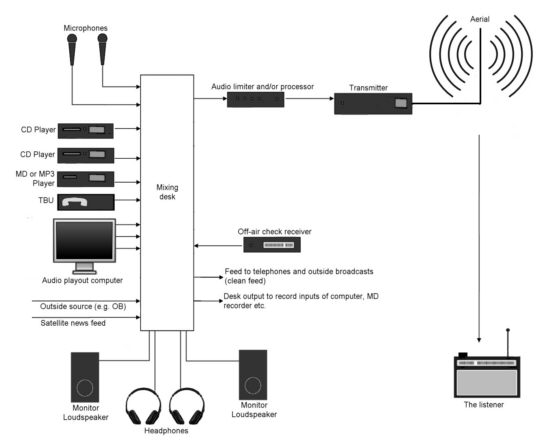
Audio from a microphone is combined with that from another microphone and recordings stored on a computer and a CD player at a mixing desk. The presenter/operator at the mixing desk can adjust which audio sources are present in the final mix and their relative levels. The output is fed to a transmitter which then sends a radio-frequency signal to the transmitting aerial. The connections between the separate elements may be in analogue or digital form but the principles remain the same.
Note that we provide for incoming circuits from outside sources, which might include a national news service from a satellite feed, network programming from other stations and outside broadcasts. Also a 'telephone balancing unit' enables the studio to include phone calls in its output.
In practice the optimum location for a transmitter is frequently different to the most convenient home for a studio centre. Many radio stations have studios and offices located in a population centre in a river valley while their transmitter sits high on a deserted hill some miles away offering a better view of the desired coverage area. A connection of some sort, usually in the form of rented lines or a separate radio link, must be established to carry the programme audio to the transmitter site.
A key characteristic that distinguishes the serious full-time broadcaster from the more casual podcaster, audio producer or temporary RSL operator is a commitment to producing the service reliably in accordance with a schedule understood by the listener. In the event of any technical failure, civil disruption or public holiday the broadcaster will continue operating. There must always be a second, completely separate means of delivering all of the station's core activities; from having more than one member of staff capable of undertaking each duty through to having more than one way of producing the service. If, for example, the mixer to fail the studio would become unusable for most practical purposes until it could be repaired. It follows that, unless the promised service can be maintained using recorded or automated programming, the station must have a second, standby, source of live programming. This might be a studio at another nearby station, a satellite studio of the main complex or, most commonly, a second studio adjacent to the first capable of presenting the normal programmes.
In a typical small station this second studio will normally be used as a production, pre-recording and training studio while remaining ready to take over transmission at the push of a button. As a result the programme chain in a typical small radio station looks like this:
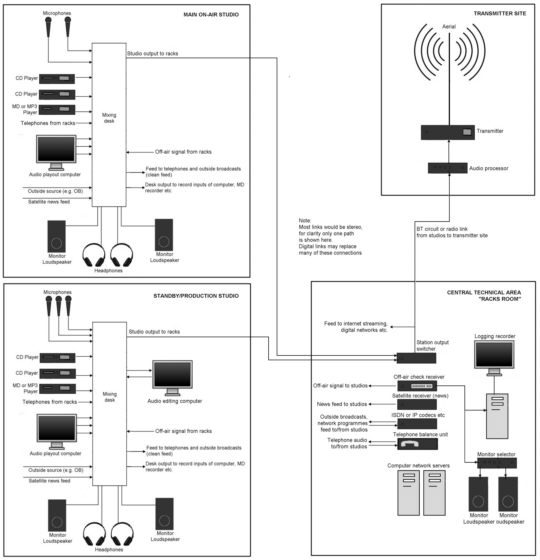
A national network service may wish to include programmes originated in studios elsewhere in the country, and may use a greater range of studios specially designed for different purposes, from live music and drama to discussion programmes, news magazines and disc-jockey style presentation. While it would be possible to simply switch between studios at each programme junction, for seamless presentation and quality control it is more common to route all the different programme sources through a further mixer in a 'continuity' studio. Typically manned by an announcer and a technical operator, it is this studio which feeds the complete network of transmitters, interjecting items such as promotional trails between the incoming programmes and playing all pre-recorded programming.
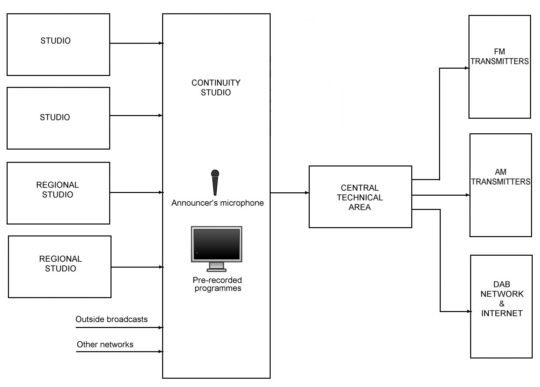
Studios
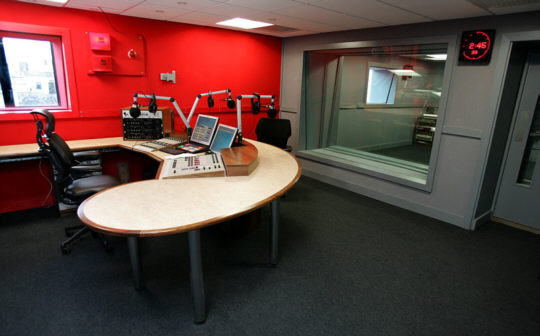 Photo: Studio Schemes Ltd.
Photo: Studio Schemes Ltd.In the early years of UK commercial radio programmes were often fed to the transmitter via a master control room where a technical operator controlled levels, added tapes and outside source material and played-in the commercials. By the mid 1970s the financial realities of local radio had become painfully obvious and station managers questioned the need to employ an engineer to keep an eye on the technical performance of a DJ. Nowadays most presenters of regular daily programmes are expected to operate the mixer and other studio equipment themselves, an arrangement commonly referred to as 'self-op'.
The once familiar model of a mixer in a control room facing a soundproofed studio area separated by a big glass panel is not really appropriate to self-op use. The presenter, seated at the control desk, needs to interact with any contributors or guests in the same room. A separate microphone area might be used for news bulletins and the like but does not need to be directly in front of the presenter. Conversely, in a production studio broadcasters often wish to create a particular sound that would be impossible to achieve in a noisy control room. With a separate studio the mixed sound can be monitored on loudspeakers in the control cubicle and the acoustic effect controlled to a greater degree. This is the way most music and drama is conventionally recorded.
Production-style studios are appropriate when originating live fast-moving speech-based shows, like news magazines or Saturday afternoon sports programmes, which involve lots of outside contributors, pre-recorded and live inserts. Separate studios and control cubicles enable presenters to continue with their scripts or interviews while studio operators and producers shout at a contributor down the telephone, or line up recorded inserts. Operators can talk privately to presenters in their headphones by using a talkback button.
While some small stations have a separate news studio many programme managers prefer the news presenter to be in the main on-air studio, better integrating the news into the programme. Nevertheless, if the news bulletin is to be shared by more than one station, or separately produced for broadcast on another service, then a separate booth will be required.
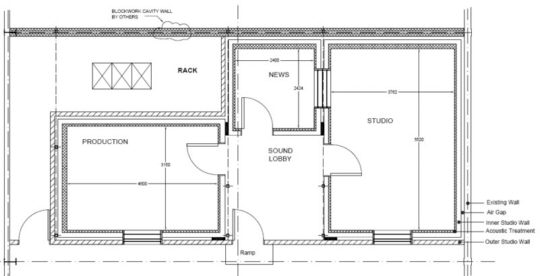
Drawing from a proposal by Studio Schemes Ltd.
This design for a typical modern local radio station is practical and economic for most purposes but would not permit the origination of more complex forms of programming. A station with a higher commitment to speech programming might add a small lobby between or in front of two studios, with a separate sound-proof door through which anyone entering the studios must pass, to reduce sound transmission through the door openings and prevent the full noise of the office ever reaching the studio. One studio is designated as the main on-air facility while the other is used for production work, training, pre-recording material and as an emergency stand-by for the on-air studio. A separate area is set aside for several standard-sized racks housing all the central equipment like receivers, link transmitters, logging recorders, telephone systems, network hubs and servers shared by the whole station. In many modern installations the racks are sited in a corner of the open-plan area outside the studios, where they contribute heat to the office for most of the year and do not require forced cooling in summer. They also make the office feel more like a part of the radio station, which is apparently impressive to visitors!
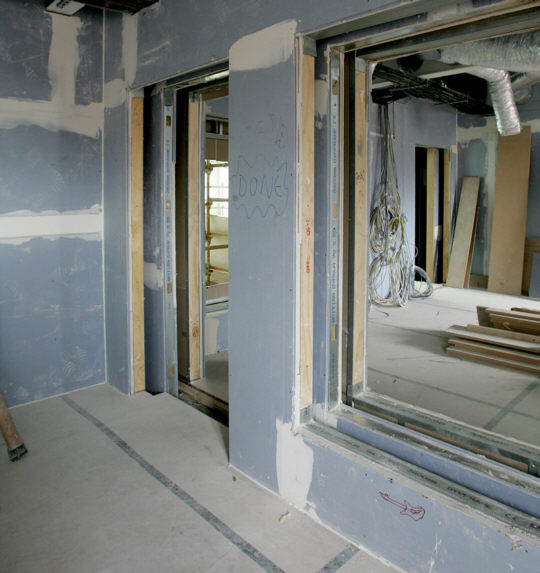
A high quality studio build project by Studio Schemes Ltd.
Purpose built studios are usually designed with double thickness walls and ceilings, the inner and outer leaves separated by a air gap (with no ties between the two), forming a box within a box, to ensure better sound isolation. A timber frame and plasterboard construction can be adequate for live on-air work, but usually with double skins of plasterboard and with rock wool filling the gap inside each wall. Viewing panels are similarly double glazed, but with an acoustic separation of several inches rather than the small gap used for heat insulation in domestic units, and are often slightly angled to reduce direct sound reflections in the studio.
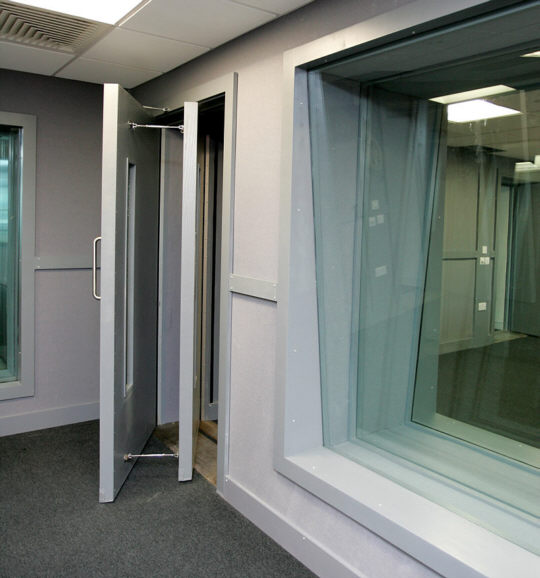
Photo: Studio Schemes Ltd.
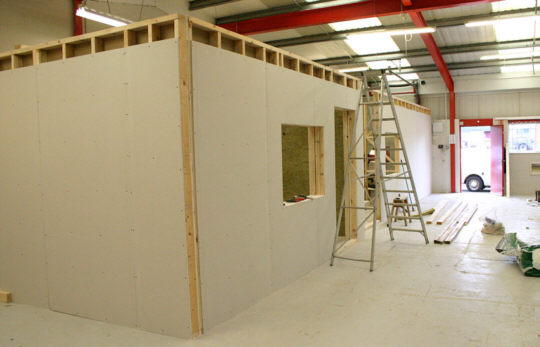 A simpler self-build project for a very small
commercial station.
A simpler self-build project for a very small
commercial station.For the best sound proofing doors can be doubled, often with one opening inwards to the studio and the other opening outwards. Walls are treated with materials designed to absorb some sound waves thus reducing reverberation to an acceptable level. This is commonly achieved using a wooden frame filled with rock wool over which a layer of special acoustic fabric is stretched. Being so well sealed with such a degree of insulation studios rarely require any form of additional heating but adequate forced ventilation and, usually, air-conditioning must be provided. Suitably quiet units must be specified.
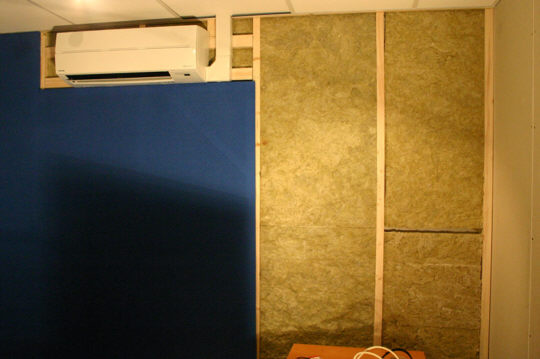
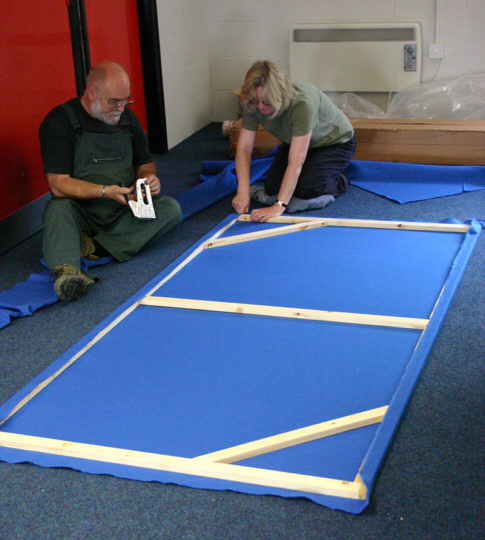
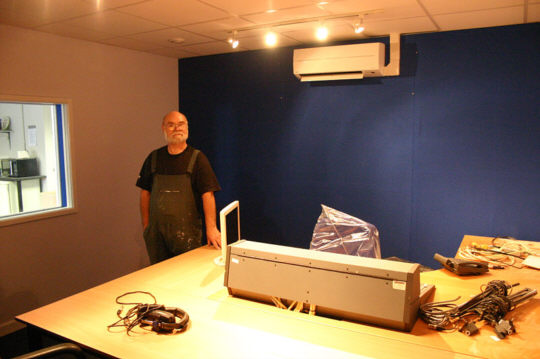
A relatively simple and cheap, but very effective, studio construction.
Photos: Brian Lister
For a typical small local station with two studios, 12 staff in an open plan area, a manager's office and an average sized meeting room the manager should look for suitable accommodation totalling at least 155 square metres. Of course, there are toilet and beverage preparation facilities required in addition to this plus storage cupboards and any separate reception area, frequently bringing the total to around 185 square metres (2,000 square feet). There is a general trend away from having a separate staffed reception area, the throughput of visitors is often insufficient to justify this and a desk or counter at the entrance to an open-plan office area is preferred. Community stations often need more space than an equivalent commercial operation to accommodate training facilities and a larger number of participants.
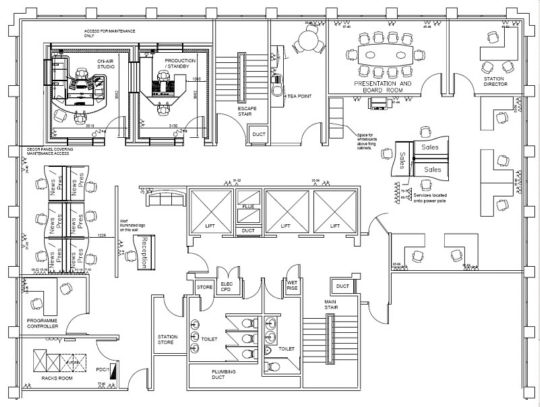
Studio equipment
The precise equipment specification varies to suit the breadth of programming and the available budget for the service, but usually includes certain essential elements which will be covered here.The mixing desk is at the heart of the studio. On-air studio mixers should have separate input channels and faders for each source commonly used within a live programme. While most mixers permit each channel to be switched to take at least one other source, a programme may easily use three microphones, two CD players, four channels from a computer playout system, a satellite news service, an outside broadcast feed and telephone calls, requiring at least a 12-channel mixer. Mixer manufacturers usually permit a reasonable degree of customisation by using different modules that fit into their standard frame, the price being dependent on the sophistication of the options chosen. For example, each input channel can usually be supplied with or without equalisation (EQ), an engineering term for tone controls. In general a presenter should not tinker with the sound of a professionally recorded item already copied onto the computer system or the sound of their own voice coming back via headphones, so it is often advisable to omit EQ controls from some of the channels. Some EQ can however be useful on location recordings and outside broadcasts. Microphone channels may have a bass-cut filter which can be switched in to remove sub-audible thumps and rumbling from microphones.
Inputs are provided for mono sources (like microphones) and stereo sources (almost everything else). Most manufacturers also provide a special module for handling telephone calls. On a digital mixer it may be possible to assign these different functions to any channel.
As well as generating the programme output to feed the programme chain, the mixer must provide outputs to headphones and loudspeakers for the control room and for any contributors on the other side of a glass panel. It must also generate talkback to contributors' headphones and enable the operator to 'pre-fade' any one channel, in order to listen to it and check the audio level before putting it on-air, and to listen to an off-air check receiver. All of these switching and level controls for the different monitor speakers and headphones are customarily included in a panel to the right hand side of the mixer.
Output levels are monitored using meters mounted centrally, usually VU meters or Peak Programme Meters (PPM), which may be either as a physical meters or illuminated bar-graph displays. VU (Volume Unit) meters are AC voltmeters designed to register the rapidly changing average voltage of an audio signal. Widely used in recording systems and throughout American radio, they are recognisable for their black scale on a white background, with a red section above the reference level of 0 dB. The PPM, designed by the BBC, more accurately indicates the exact level of brief peaks of audio and is easier to read. The PPM rises rapidly to show a peak, dropping afterwards at a more leisurely pace. As distortion occurs in broadcasting when peaks exceed a certain level this meter tells us what we really need to know. The PPM conventionally has a white needle and scale on a black background, with no red section, the scale is simply numbered between 1 and 7. The standard reference level is represented by the number 4 and peaks should not exceed 6. Stereo signals can be displayed either using two separate meters or a twin-needle meter in which the left and right signals deflect red and green needles across a single scale. A new form of meter designed to indicate the subjective loudness of programme material is being introduced in some areas. Developed particularly to address situations such as television commercials sounding louder than the surrounding programmes, the ITU-R BS.1770 standard defines the technical chatacteristics of such a meter.
Individual models of microphone are designed for different applications and to give a variety of different directional patterns. Some are fitted with a small switch to change their directional properties or to filter out excessive bass frequencies. Most broadcasters have their own preferences and the manager would be well advised to get opinions on the makes and models favoured by similar stations before making any purchase decisions.
The same advice applies to the choice of other audio equipment. Today many radio studios do not have any CD players, tape players or turntables, basic facilities being provided elsewhere to transfer audio from such formats onto a central digital audio server, but where they are purchased they are generally of more rugged construction than domestic models. A professional version of an audio player seldom offers higher audio quality than the domestic equivalent but usually offers professional balanced audio outputs and more substantial buttons and switches to withstand the demands of professional use.
Computer playout systems now offer so many advantages over traditional audio recording and playback equipment that it would be hard to imagine a new studio without one. A large number of non-compatible proprietary systems are available and the choice of supplier is frequently dictated by the system already in use elsewhere in a station or network. While a number of basic software solutions are easily found on the internet which might be suitable for use by small voluntary operations, the better known industry-standard systems such as Dalet, Enco, RCS Master Control and Myriad offer an impressive range of facilities beyond the simple storage and reproduction of audio files. In particular they are designed to integrate with music scheduling, programme preparation and sales traffic software and to output logs for use in music copyright and advertising reports. As a result the presenter can be provided with a complete on-screen running order, complete with all audio files and scripts, as soon as they walk into the studio. At other times the same system can be set to run without presenter intervention, the mixing desk often being designed to be switched out of circuit to be used for other purposes while the computer handles the on-air sequence.
Other items required in on-air studios include a telephone balance unit (TBU), which converts the two-way signals on a telephone line so that they can be separately fed from, and to, a studio mixer; monitoring loudspeakers; headphones (for all who need to monitor the output while the microphones are open) and at least one reliable clock (usually a radio code clock locked to a transmitted time signal).
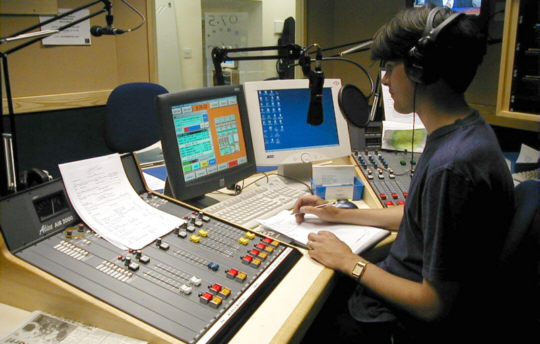
Photo by Brian Lister
A production studio in a small station - one that doubles as a back-up on-air studio - must normally contain all the facilities listed above, plus a few more required specifically for production work. The mixer will often contain more input channels than are needed in the on-air studio, often by omitting a central script area, and more channels may be equipped with EQ and auxiliary outputs for echo and other effects. A production mixer may also have a master fader which can fade-out the entire output, a very useful facility to produce a tidy end to a complex mix but of dubious value in an on-air desk.
The need to reliably remain on air 24 hours a day leads the prudent radio manager to specify at least two of everything: two studios capable of going live; each with at least two microphones and two sources of audio for recordings and commercials. There is however another more routine reason to apply this 'rule of two' in radio studio design: in order to hand neatly from one voice to another, or segue from one piece of music into the next, or to cross-fade between items, the studio must have more than one channel for each type of audio.
It is harder to quantify the need for a second source of mains power for the studios and transmitters. While it is relatively straightforward for an engineer to estimate the costs involved in providing a standby supply, it is really a programme manager who must justify the expenditure. Any loss of income caused by the station being off the air for, perhaps, a twelve hour period once a year can often be recovered and will not be a significant argument in itself for additional capital outlay. Rather a value must be put on the degree to which the station's relationship with its listeners will be damaged, and in this case it is often the smallest stations, those closest to their listeners, who have the most to lose. At times of a major disaster, flood, storms and snow, or during political or social crises, listening to the radio increases. Further, in such circumstances authorities often advise the public to stay tuned to local radio and, without mains electricity, many listeners have few other options.
It is at such times a local radio station can cement its connection with the community it claims to serve. For a simple service it may be possible to get by on battery power if the options are worked out in advance. During the planned power-cuts resulting from a coal miners' strike in the early 1970's at least one BBC local radio service reputedly stayed on the air using a small battery-powered mixer intended for outside broadcast use with recorded items being inserted from a portable recorder. Today most stations would be lost without their computer system and, while its supply may be maintained for a short while using an uninterruptible power supply (UPS), any greater resilience requires investment in a stand-by generator (there is seldom an opportunity to hire a generator in such situations) and proper alternative mains wiring for the essential items to be supported by it.
Outside Broadcasts
Few things confirm a radio station's relationship with its target community as straightforwardly and immediately as a live outside broadcast (OB). Ranging from the hastily arranged live report from the scene of a news story, through the slightly more pre-planned coverage of a sports fixture or public event to the stage managed station promotional happening, the remote link-up demonstrates the often unique connection between the station and a geographic area or community of interest. If executed with care the broadcast will impress both the listener at home and those - particularly those not already regular listeners - present at the event.Live outside broadcasts use mobile or portable studio equipment with radio links, telephone lines, ISDN circuits or mobile telephone technology to transfer signals back to the studio. Careful planning of the technical resources for each event, whether it's a live concert, news story or station promotion, is very important. For example consideration must be given to adequate communication between the studio and the presenters live on location.
Historically there was little choice but to hire an analogue BT line, often specially installed at considerable cost, to link the OB site to the studio. A separate - usually lower quality - "control circuit" would supply a return feed of programme audio and talkback from the studio. At regularly used locations, for example Premiership football grounds, it was often found cheaper to use permanently installed "local ends" - connecting the OB equipment to them when required.
From the late 1980s onwards ISDN replaced many of these permanent and temporary circuits. Small portable mixers with built-in ISDN codecs could be plugged into an ISDN port and provide two-way communication between the location and the studio. Good quality speech broadcasting was possible using a single ISDN port, BBC stations tending to use G722 codecs to digitally code the audio while commercial stations settled on the incompatible apt-x system. Using the full capacity of an ISDN connection even permitted broadcastable stereo music to be sent by ISDN, most commonly using MPEG coding.
Unfortunately it seems likely that ISDN will eventually be withdrawn in favour of the broadband connections which are becoming the norm for a growing number of businesses, households and potential OB venues. While theoretically capable of much higher quality and/or a greater number of channels of two-way communication than ISDN, the IP based solutions using broadband suffer from a design characteristic of the Internet which is of little importance to most other users. Data is distributed across the Internet in "packets" which are reassembled in order at the receiving end. Some packets may take longer to arrive than others but, with a sufficient buffer delay at your computer, it all appears in order in the end. We can also accept the odd data drop out or occasional need to resubmit a request when browsing the web, but this generates awkward gaps or even unpleasant sounds when listening to streaming audio.
To reliably achieve the best quality at the moment requires quite a long delay - sometimes of the order of up to several seconds - which can make two-way conversations and interviews awkward or even impossible. Nevertheless, advances in broadband speeds and reliability may remove this concern in the coming years and, of course, if the complete programme is being sent from the remote location this may not be an issue.
A common alternative option has been to use a specially licensed VHF or UHF frequency to send location audio back to the studio. Usually another VHF frequency is used in the return direction to provide talkback and cue audio. The ubiquitous BBC radio car is the classic example of this approach, a small mixer and transmitter installed with a pump-up mast in a suitable, well liveried, vehicle. A fixed receiving aerial at base or on a high hilltop mast provides the other end of the link. Simpler systems, often based on UHF studio-to-transmitter link transmitters and receivers, can be made portable and temporarily installed for the duration of a broadcast. While limited in range such links are eminently suitable for use in the limited editorial area of a small local station. Major broadcasters, typically producing programming for a national network, may similarly use a mobile or portable satellite uplink which can give coverage from a large part of the globe.
Developments in audio compression algorithms have made it possible to squeeze acceptable speech audio into a much narrow bandwidth than previously thought possible. A number of units from manufactures such as Comrex offer the ability to return good sounding speech from a reporter at any site with access to a telephone connection. Using a standard GSM mobile phone card some units make it possible to send news reports and programme inserts from anywhere with a good mobile network coverage.
While such digital units, usually containing a simple mixer and return feed to headphones, can seem quite expensive they considerably simplify the issues surrounding getting "out and about". The cost of the portable unit and the companion codec back at base may often be justified from additional sponsorship revenue, or in community radio might be funded by a separate grant to allow greater access for a particular purpose. If used regularly the cost may appear more moderate on a per-occasion basis.
As so often in radio, the manager may be tempted to over-complicate what is required of an OB. An early BBC local radio producer who became Metro Radio's first Programme Director once told the writer: "The main reason to do an OB is to give credibility to our coverage and involvement. We do that in the first ten seconds, anything after that is a bonus."
While it may be impressive to broadcast whole programmes - including music and other inserts - live from the location, in practice the listener's experience will be the same if all recorded music, other audio items and advertisements are played-in on cue by a technical operator back at the studio. Frequently it may be more effective to maintain a studio-based presenter who can keep the show moving while the presenter on location lines up the next insert.
Indeed some events may be better covered with recordings rushed back to the studio - or sent back via an OB link or simply by email. It is often easier to capture the right moment, or intercept the ideal interviewee, at a time other than when the studio chooses to come across for a live insert. With a little thought and practice at both ends it is not even necessary for the listener to be aware that the piece is anything other than live. The presenter in the studio might cue into it with an agreed line like "So Jenny is it still sunny there?" or "What can you see happening now?" and the piece starts with an appropriate reply. Simply saying that Jenny is at the event and will be reporting throughout the afternoon is not misleading or inaccurate.
The need to host the whole show from a public location is often dictated more by promotional and marketing considerations than any benefit for the listener at home. See Section 2.8 for a brief discussion of this point.
For a very useful guide to setting up outside broadcasts in community radio setting, including a step-by-step guide to the technical management of the outside broadcast see Jones, 2003.
Transmission
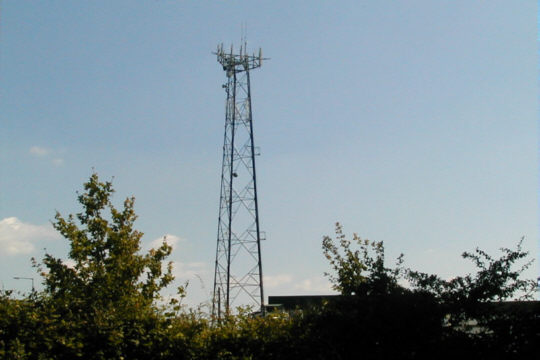
Photo: Brian Lister
Even in the most deregulated communications market some statutory control is required over the use of radio frequencies. Every radio transmission of any kind is based on a carrier signal - an electromagnetic wave varying a defined number of times per second, this number giving the frequency expressed in Hertz. An electronic circuit resonating at the required frequency can separate one transmission from another. However once a particular frequency has been used in a given area it cannot be used again by another analogue transmitter unless the second station is far enough away that the signal will not cause any noticeable interference in the first station's area.
At VHF, UHF and microwave frequencies the earth's curvature normally ensures that the most powerful transmitter will only cover a radius of about 50 miles before the signal flies off into space. Many local stations use lower radiated powers meaning that their effective range will typically be lower still. In this way a single frequency, for example in the FM band, may be reused repeatedly across the country. At lower frequencies a further complication, used to great advantage by short-wave broadcasters, is the refraction of radio waves as they travel through the layer of the earth's atmosphere known as the ionosphere. Greatly influenced by the sun's energy, even the presence of sun spots, the ability of the ionosphere to deflect radio waves back to earth is dependent on the frequency in use and the relative position of the sun at different times of day. In the case of the medium and long wave bands this leads to a considerable increase in transmission range after dark. As a result frequencies in these bands must be allocated by international agreement, each nation being allocated only a certain number of spots on the dial for its services.
AM (amplitude modulation) is the original method devised for broadcasting speech and music by radio. Here the amplitude of the carrier signal is increased and decreased with the variations of the, much lower, audio frequencies. A common alternative is FM(frequency modulation) where the carrier frequency is varied around the nominal frequency in proportion to the audio voltage. Only during silence is the FM signal on exactly the published frequency.
FM has two key advantages: firstly, as the instantaneous strength of the received signal is irrelevant, it is less susceptible to fading and noise; secondly, as the amount that the signal swings up and down the band, known as the deviation, is increased the effects of interference become less pronounced. In order to benefit fully from these advantages an FM signal needs more bandwidth than the equivalent AM signal and therefore these stations could not be accommodated on the old long and medium wave bands. The VHF radio broadcast band stretches from 87.5 to 108 MHz, offering 19 times the bandwidth of the medium wave band. To avoid interference between nearby stations Ofcom and the BBC usually allocate frequencies so as to keep stations in the same area at least 400 kHz (0.4 MHz) apart.
With a variety of national networks, region-wide services and very local services to fit into a finite band it will be seen why frequency allocation can become a very complex issue. A major role of Ofcom, not only for broadcasters but for the many other users of the radio spectrum, is to manage frequencies so as to get the best use of them for as many users as possible without mutual interference. In practice, and in the eyes of many rather inefficiently, the FM broadcast band has been divided up to allow Ofcom to allocate frequencies in some segments while the BBC effectively manages its own allocations in others.
In addition to the single mono signal described above FM transmissions can carry additional signals to provide stereo audio and things like Radio Data System (RDS) information. At the FM transmitter site a stereo encoder is used to superimpose the stereo information onto the broadcast signal and an RDS generator produces the data signals, although these units may be included within the transmitter itself, particularly in systems designed for smaller operations.
The RDS data is designed to supply information to FM receivers and includes 'static data', such as a unique programme identification code, programme service name (in eight characters), alternative frequencies (to allow automatic retuning) and traffic programme identification (which tells a car radio that the station regularly broadcasts traffic information). Separately the RDS system can also carry 'dynamic data', fed to the transmitter site from the studio. It can include, among other things, a traffic announcement signal (which can switch a car receiver from other sources of audio during travel bulletins) and a scrolling text display of, for example, song titles or phone numbers.
The system of Digital Audio Broadcasting (DAB) introduced in the UK, technically the Eureka 147 system, uses two digital technologies to produce a transmission system designed to overcome some of the limitations of FM broadcasting. Firstly the digital audio is compressed using an algorithm called MPEG Layer 2. A predecessor of the now ubiquitous MP3 format and the newer more efficient AAC+ standard, this reduces the amount of data required to broadcast each signal by ignoring sounds that will not be audible to the listener. Secondly the resulting digital signal is transmitted as a Coded Orthogonal Frequency Division Multiplex (COFDM) splitting the signal across 1,536 different carrier frequencies and thus ensuring that it can be received reliably even in if some of the carrier frequencies are affected by interference or interrupted briefly. The COFDM technology is also immune to signals arriving at different times, such as those from other transmitters carrying the same programmes or from reflections of hills and buildings, meaning that the transmitters can be arranged in groups using the same frequencies to cover a larger area.
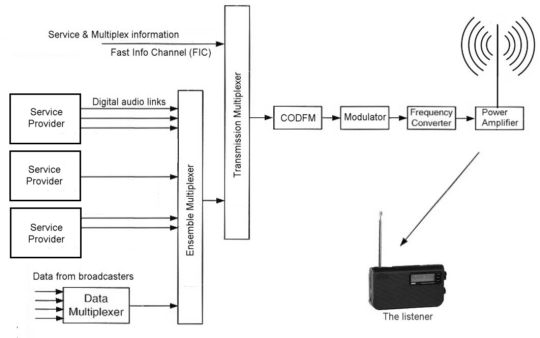
While, at least since the 1990 Broadcasting Act, the AM and FM broadcasting chains, from microphone to transmitter, can be under the control of the broadcasters themselves, the DAB system is structurally very different. In order to make efficient use of COFDM and the available frequencies a number of services must be carried, or multiplexed, onto a single broadcast frequency to form a DAB ensemble. Within the total bit-rate the ensemble can handle, individual stations can be allocated different bit rates and some capacity can be used for other data services. The number of stations carried by one DAB multiplex depends on the average bit rates used and therefore the quality of audio broadcast. Services are charged according to the amount of the total data bandwidth they wish to use, stereo services using twice the capacity of an equivalent mono service.
The radio station becomes a service provider and generates a stream of audio data complete with programme associated data and service information which is used to describe the service. This data is sent to a multiplex operator who combines these services with a number of others to form an ensemble. The complete ensemble of services can then be broadcast from a number of transmission sites, the listener being able to select an individual service from the received multiplex.
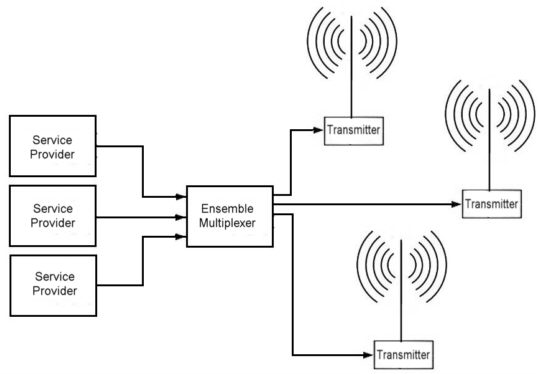
In the DAB system the multiplex operator holds the main broadcasting licence, the service provider having to negotiate carriage for their service (see Section 2.4 on licensing). The system assumes the country can be divided up into fairly large cells, each served by a handful of multiplexes, in which all the services wish to cover the same geographic area. As a result DAB is not popular among smaller local commercial stations in the UK, where there is little benefit in increasing costs to generate a signal beyond their area of editorial appeal, and the technology has not been adopted at all in the USA. An alternative approach, in-band on-channel (IBOC), is marketed in the USA as HD Radio. Here extra carriers transmit the digital signals alongside the relevant AM or FM station on its existing frequency. Existing analogue radios can still be used and listeners can switch to digital at a steady pace until eventually stations could remove the analogue signal and become all digital without changing frequency. However there remain issues with the relative range of the digital signals, receiver sensitivity and interference caused by the broader sidebands of the new transmissions.
An alternative digital transmission system for the old AM bands has been developed by Digital Radio Mondiale (DRM). Using various MPEG-4 codecs, DRM can deliver similar quality to existing FM stations while allowing more stations to co-exist in the bands and using many of the existing AM transmitter facilities. DRM is claimed to be robust against the fading and interference that often plagues conventional broadcasting in these frequency ranges and can add RDS-like data to the transmissions. While, unlike the US HD radio, it is not designed to broadcast "piggy- back" with AM radio on an existing frequency, DRM would be much cheaper to implement than DAB and might offer a digital route for smaller broadcasters reusing unwanted AM frequencies. It has already been approved for medium wave and shortwave broadcasting throughout the world, with the exception of the Americas, by the International Telecommunication Union (ITU) and a comparable system, DRM+, for use in the existing VHF/FM band has also been developed.
The bands of frequencies currently used for conventional radio broadcasting in the UK (NFPG 2007) are shown, with their key characteristics, in the following table:
| Frequencies | Mode | Notes |
| 148.5 - 283.5
kHz |
AM |
Long Wave.�Now only used in the UK by BBC Radio 4 at 198 kHz . Has advantage that signal can extend over the horizon giving national coverage from a single transmitter in daytime. |
| 526.5 - 1,606.5 kHz | AM | Medium Wave. Local coverage in daylight, but after dark signals can be heard from across Europe and beyond. |
| Various between 3.95 and 26.1
MHz |
AM | A number of separate Short Wave bands. Can give worldwide coverage, different frequency bands being needed as the earth rotates relative to the sun. |
| 87.5 - 108.0 MHz |
FM |
FM broadcast band. Rarely any long range interference. Higher quality due to the greater bandwidth available. |
| 217.5 - 230.0
MHz |
DAB |
Digital Audio Broadcasting via multiplexes which repeatedly reuse the available frequencies. |
At the time of writing, conventional FM or AM reception remains the way most listeners receive the majority of radio programmes in the UK.
According to research data (Rajar 2009) for the�first quarter of 2009,�67.5 percent of all UK radio listening was identified as being via such analogue channels, with 20 percent via a named digital source (DAB, Freeview, satellite or the internet). One third of the population said they tuned in at least once a week to some form of digital audio broadcasting.
Inevitably digital reception will overtake analogue in the next few years, but it is expected to be a slower process than we have seen with CDs or digital TV as the average UK household has five radio sets (Ofcom 2006) and some analogue transmission will need to continue until the majority of these are capable of digital reception. We listen to radio in bed, the kitchen, the car, at work and on a range of portable devices as well as in a more controlled situation at home in our lounge or dining room. Arguably the optimum means of delivery in each of these situations could be via a different mechanism or network, so the debate goes much beyond the pros and cons of today's DAB system.
Managing the transmission system
While, in the past, station management became involved in initial decisions about the location and power of a transmitter, or network of transmitters, to optimally cover a desired geographic area and the appointment of a specialist company to maintain the service, in future the radio manager will have to ensure reliable distribution via a number of digital routes. However the aim remains to serve as many of the target population as possible for the minimum capital outlay and ongoing cost. It is possible to summarise distribution costs under two headings:CAPITAL
Commissioning forecasts of coverage area.
Design of system, planning consents etc.
Installation of transmitters.
Installation of aerials.
Decisions on extent of stand-by or back-up facilities.
RECURRENT
Ongoing rental of transmitter sites, masts, etc.
DAB multiplex charges.
Fees to other digital distributors.
Fees to AM/FM transmission supplier.
Electricity costs at transmitter.
Regular maintenance checks.
Repairs and replacement.
Studio-to-transmitter line rental or radio link licence costs.
Standby studio-to-transmitter link costs.
While the threat of eventual analogue switch-off makes consideration of long-term transmission agreements more problematic, in the past many broadcasters have preferred to pass the whole task of transmitting their programmes to a specialist company. The largest, Arqiva, grew out of the old engineering department of the Independent Broadcasting Authority. When legal commercial radio started in the UK, and throughout the 1970s and 1980s, the radio stations and ITV companies were technically 'programme contractors', simply required to originate programming while the big hilltop transmission masts were staffed by IBA engineers. To this day many large stations enter into a 'Total Broadcast Contract' with Arqiva under which the specialist company provides a fully outsourced transmission service, including ownership and maintenance of the transmitter system and responsibility for the studio-to-transmitter links. Smaller operators, particularly those using more modest transmission sites, often choose to own and operate the transmitters themselves, usually with specialist transmitter engineering support from one of several well qualified UK companies.
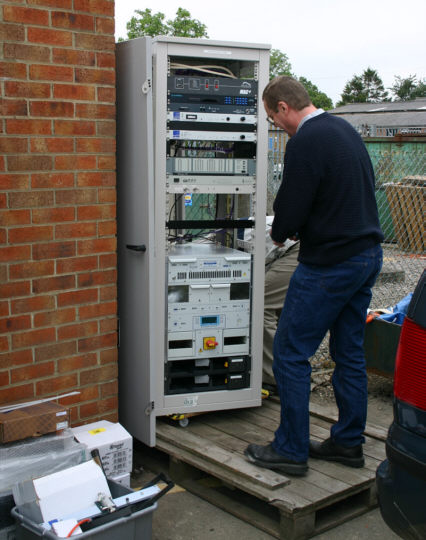
Tim Foulsham of transmission supplier Radica instals a pre-wired rack including all the equipment needed for transmission and back-up studio links for a local FM service.
Photo: Brian Lister
If choosing a site to locate its own transmitter mast, the station must consider a number of factors:
1. The height and location of the site in relation to the main population centres.
2. The location in relation to the studios (there will need to be some kind of radio or cable link between the two sites).
3. A reliable electricity supply must be available.
4. The transmitter equipment and the aerials must be inaccessible to the public for safety reasons, and to prevent pirate operators from stealing the kit. Secure fencing and solid locked doors must therefore be provided if not already present.
5. The building housing the equipment must be free from damp and well ventilated. Any other equipment should be safely and tidily installed and there should be no fire risk.
6. The mast or other structure must be capable of taking the weight and wind- loading of the proposed aerial system.
7. Engineers must be able to gain access 24 hours a day, ideally holding a key for the site at the studios.
8. Planning approval will almost certainly be required.
Back-up transmission systems
As with the studios, station management must decide on the extent, if any, of emergency standby equipment. Modern transmitters are very reliable and now are often solid-state. So there is little to go wrong with the transmitter itself, transmission breaks being more commonly caused by a mains power failure, an interruption of the studio to transmitter feed or even an aerial problem. Nevertheless, most transmitter installations include some form of automatic switch that will power-up a standby transmitter or take an alternative programme feed if the main system fails. Often the operation of the switch will be signalled to the studio centre or another operations centre where the status of the transmitter can be monitored.This is another situation where the manager must weigh up the relevant risks, costs and benefits. If the transmitter is 99.9 per cent reliable we might expect it to fail for about 9 hours in the average year (that is assuming you could get it fixed straight-away) and yet completely duplicating a transmission system will virtually double the cost of the installation. How much would it really cost the station, in lost audience, public image and sales revenue, if it were off the air for part of one day once in a year? Is the standby transmitter really worth the extra cost?
As with the studio example, decisions must be made on whether to require stand-by generators at the transmission site to keep the station going indefinitely in the event of mains failure, or the provision of an uninterruptible power supply (UPS), usually the type now used widely to protect computer systems, which can maintain a lower power transmitter for an hour or more.
Power and coverage
The effect of higher transmitter power on the population coverage of a station is often overestimated. The effective range, in a perfect environment with no hills, forests or man-made structures, is governed by the 'inverse square law'.Power sent down a cable is lost linearly, the signal travels only in one direction, therefore when the length of cable is doubled so is the loss of power. In contrast a broadcast signal expands in all directions. So as the distance between our transmitter and receiver doubles the received power drops by a factor of four, or if the transmitter is ten times further away we need 100 times the effective radiated power to receive the same signal. Add to this the limiting effect of hills and even the earth's curvature and you can see why managers are often disappointed at how little difference a power upgrade appears to make. Put simply, doubling our transmitter power does not double our range in miles.
Additionally radio signals are transmitted with a particular polarisation, usually horizontal or vertical. As with polarised light it is possible to separate these components at the receiving end. This is simply achieved using a horizontal or vertical rod aerial. In the early days of BBC VHF FM radio it was thought that most people would be using a fixed rooftop aerial and it was decided to mainly use horizontal polarisation for practical antenna design reasons, this is why the rods of an outdoor fm aerial were normally horizontal. However, around the time that UK commercial radio was launched in the early seventies, the FM car radio and portable radio became the norm, both being most conveniently equipped with a vertical aerial.
A special aerial array is needed to transmit a mixed polarisation signal and it must be fed with a proportion of the total transmitter power going into each of the vertical and horizontal planes. As a result broadcasters on a tight budget (not just community services but smaller commercial operators as well as small relay stations for larger networks) tend nowadays to use only vertical polarisation. While giving savings on transmitter power and antenna costs, using only the vertical component gives perfectly adequate coverage on the mobile and portable receivers used by most listeners. DAB is always broadcast using vertical polarisation only.
By far the most important factor in getting the maximum coverage for a given radiated power is the height of the transmitting aerial. The best results can be obtained by renting space on an existing tall mast used for television transmission or mobile phones, but the old TV towers are often miles outside the most heavily populated areas and can prove very expensive, not only in the rental charges but also in having the antenna system professionally rigged at height. Smaller stations often use the roof of a tall structure in the heart of their target area, although there may be limitations if there are homes very nearby. Nevertheless a solution that puts the maximum signal strength into the core of the target area, with the signal diminishing with the population to the outer fringes, is often very attractive.
Stations on a tight budget or with limited licensed power should bear in mind that on FM a mono service will have an appreciably larger coverage area than a stereo station using the same radiated power. This is partly because stereo FM signals are more susceptible to noise and multipath distortion than mono signals but also because transmitting the stereo information and a continuous 'pilot tone' uses up some of the available frequency deviation - reducing the maximum audio level that can be broadcast. The reader can demonstrate this using a receiver that can be switched between mono and stereo reception. Tuning to a stereo FM station with borderline reception there will be a fair amount of noise on the signal, mainly in the form of high frequency hiss. Switching the receiver to mono most of the noise will disappear. Although the improvement is not noticeable in a strong signal area it can make a big difference at the fringe.
Audio compression and processing
Although despised by audio purists a signal processor can increase a station's apparent loudness, encouraging listeners to select it from a crowded band, while giving the service a distinctive signature "sound" which may encourage them to stay.The human ear is capable of hearing a wide range of sounds from the very quietest to those so loud as to cause physical damage. In most cases what makes a sound too quiet to hear properly is not the ability of the ear but the amount of background noise getting in the way. Radio engineers have devised a number of systems to ensure that quiet passages in programming are not lost in the noise, and to understand these it helps if the radio manager has some grasp of the main unit used to measure sound levels, the decibel.
The bel is a unit of loudness named after the inventor of the telephone, Alexander Graham Bell. Unfortunately the unit is a little too large to be useful in everyday work, and the standard unit is now ten times smaller - the decibel (dB). The decibel is a ratio on a logarithmic scale, not an absolute measurement like the volt. For example, while an increase in loudness of 10 dB means the signal will be ten times more powerful, a decrease to one-hundredth of the power is equivalent to a change of minus 20 dB and a power increase of a thousand times is expressed as plus 30 dB.
The human ear can cope with a massive range of around 120 dB from the quietest to the loudest sounds, known as the dynamic range of the ear. A good FM radio can provide a dynamic range of only around 70 dB, that is to say the difference between the background noise level and a high audio level which would cause distortion is 70 dB, and a typical AM radio might offer as little as 10 dB. It is clear that the dynamic range of sounds we hear in the natural world must be reduced in order to be heard satisfactorily on the radio, even before we factor in the masking effect of background noise in the home or the car where the receiver may be located.
At its simplest the dynamic range of programme material can be electronically reduced by limiting the loudness of the highest peaks or by increasing the volume during the quiet periods. These processes are known as limiting and compression (which must not be confused with digital compression, a totally unrelated process in which the amount of data used to define an analogue signal is reduced). Most limiters and compressors will reduce a high signal very rapidly, to prevent distortion, but increase a quiet signal more slowly.
As it is a breach of licence conditions for a transmitter to be over-modulated there will certainly be a limiter at the transmission site to catch any loud passages sent from the studios. By setting the limiter so that it increases the level of quiet signals by, say, 10dB and therefore reduces the loudest normal peaks by 10 dB, a noticeable increase in average modulation and therefore perceived loudness can be achieved. However there is a limit to how far you can increase perceived loudness using this simple compression. If employed beyond a certain degree the compressor will be heard to be increasing the level of background noise to fill the gaps between words, and irritatingly adding a strange pumping effect to the loudness of individual instruments in music.
In order to increase the amount of automatic control without such extreme effects, modern audio processing equipment works on the principle of splitting the audio signal into several different frequency bands before constantly adjusting the level of each band separately. The degree of compression and the relative level of each frequency band can be adjusted separately and it is here that the manager will frequently become involved, attempting to set up a distinctive, powerful yet pleasant 'signature sound' for the station. Setting up a system of this kind takes time and patience, there are so many variables that the manager or engineer may never be confident that they have got it perfectly right. It is usually best to start with one of the factory-defined array of settings, varying it to suit the service's particular programme mix, transmission system, and competitive marketplace.
Web streaming
Unlike conventional broadcasting, Internet radio is usually distributed over the net to each listener on an individual basis, feeding each computer with its own effectively continuous stream of data.While the average PC with a broadband connection can send a handful of streams simultaneously a much bigger array of servers with a vastly more substantial connection to the Internet is required if you wish to broadcast to hundreds or thousands of listeners. As a result most stations generate only the basic data stream at the studios, passing it on via the Internet or a dedicated digital line to a third party specialist streaming company whose data centre has the capacity to cope with peaks of demand.
Webcasting is distinct from "listen again" and "podcasting" which involve downloading specific audio files on demand, and the three concepts now happily co-exist in the minds of most listeners. The BBC offers a "listen again" service in parallel with the ability to hear its main services in real time, while podcasting tends to refer to the downloading of single programmes made specifically for the purpose.
While an advantage of Internet radio services is that even the most local station is theoretically accessible from anywhere in the world there are copyright complications. For example many UK stations are required under their Phonographic Performance Ltd. music copyright licences to "geo-lock" their streams - making them available only to users with UK IP addresses. Some other content, for example sports commentaries or live performances may be licensed for use only within one country.
In order to squeeze as much audio bandwidth as possible through a domestic Internet connection most webcasting uses a "lossy" digital coding scheme which discards some of the less noticeable audio content. Popular streaming audio formats include MP3, Ogg Vorbis, Windows Media Audio, RealAudio and HE-AAC (AAC+). Because the coded data is sent over the network in distinct "packets", which may be routed differently over the Internet, they have to be reassembled in order at the receiving computer creating a short delay before they can be played. In the event of any disruption to the connection this delay manifests itself as a pause while the receiver is "buffering" a store of packets.
The quality of streamed audio depends on the chosen bit-rate, measured in kilobits per second (kbps). Some advanced systems will automatically drop back to a lower bit-rate in the event of a problem with transmission to an individual listener.
Common bit rates are:
16-22 kbps: Originally used for early dial-up computer modems. While adequate for speech radio it is comparable to AM radio and seldom used today.
32-44 kbps: These speeds are best for non-broadband listeners who still use a 56.6 telephone modem connection. Some unpleasant effects on music but fine for speech.
128-192 kbps: For listeners with broadband connections these speeds are capable of near-CD quality.
The BBC currently uses AAC coding at 128 kbps for the majority of its streamed services via the iPlayer, increasing to 192 kbps to give even higher quality on BBC Radio Three. At the lower speeds it is worth considering broadcasting in mono rather than stereo as this effectively doubles the bit-rate available for a single audio channel.
In common with many broadcasters the BBC uses separate audio processing on the input to its streaming servers, different to that used for FM or AM, at far less vigorous settings than those used for conventional broadcasting. The BBC services on Freeview (digital satellite) and the Internet are the least processed of all, with no processing at all on the Radio Three signal.
In future streaming audio to portable devices should become even more attractive with the eventual roll-out of so-called 4G networks. WiMax can be seen as an extension of our current very localised Wi-Fi networks while LTE is more an extension of mobile telephone technology, but both are basically IP networks offering high speed Internet access on the move. Nevertheless many believe such one-to-one streaming will never be as technically efficient or economical as conventional broadcasting's one-to-many model.
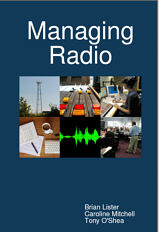
Go to main page